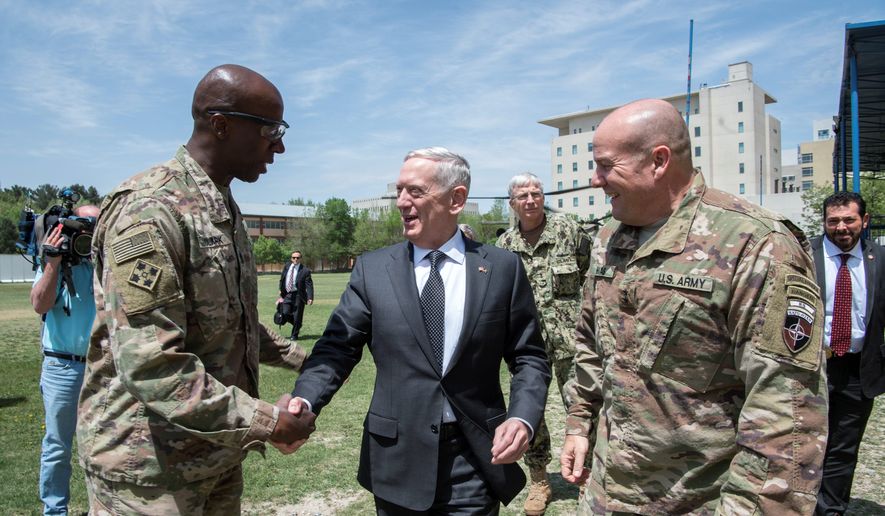With the Pentagon poised to announce details of a troop increase for the U.S. mission in Afghanistan, the pending decision raises questions about the effect additional boots on the ground will have on the 16-year conflict.
Defense Secretary James Mattis and Chairman of the Joint Chiefs of Staff Gen. Joseph Dunford made the rounds Wednesday on Capitol Hill, reportedly briefing lawmakers on the White House’s strategy for Afghanistan and on the ongoing coalition campaign to defeat Islamic State in Iraq and Syria. The Pentagon repeatedly has said its Afghanistan war plan would be on President Trump’s desk by mid-July.
For several weeks, defense officials led by Mr. Mattis have been assessing the progress of the Afghanistan war, determining what level of support — including a 3,000- to 5,000-troop increase — will be required to stabilize the country’s security forces.
Government-led analysis and reviews by private sector analysts say upwards of 60 percent of Afghanistan is heavily influenced by or under the direct sway of the Taliban. Afghan troops, advised by U.S. and NATO forces, have suffered heavy casualties to maintain control over the 40 percent of the country ruled by the central government in Kabul.
The war in Afghanistan received little attention on the campaign trail last year, with Hillary Clinton and Donald Trump focusing on the U.S.-led coalition to defeat the terrorist group known as ISIS or ISIL. But Washington refocused on Southwest Asia amid Taliban gains this spring and the increased Islamic State presence in the eastern half of Afghanistan.
“We are not winning in Afghanistan,” Mr. Mattis told members of the Senate Armed Services Committee last month. His comments echoed those of U.S. Central Command chief Gen. Joseph Votel and Gen. John Nicholson, the top American commander in the country.
Currently 8,400 U.S. troops are in Afghanistan, training and advising local security forces. Should the top-end troop increase proposal go into effect, it would raise the number of U.S. forces in the country to more than 10,000.
On top of the increases sought by the Pentagon, NATO leaders have agreed to send surge forces into the war-torn country. NATO Secretary-General Jens Stoltenberg announced the decision during an alliance ministerial earlier this year.
Inside the Pentagon, hopes were high that President Trump’s emphasis on military might to achieve U.S. national security objectives coupled with a hands-off management style would give the department the resources and leeway it needed to bring the Afghan war to an end. Those hopes were bolstered when the administration announced decisions on troop numbers would be the exclusive domain of Mr. Mattis and his staff.
But recent reports claiming that National Security Adviser H.R. McMaster instituted a soft cap of 3,900 soldiers, sailors, airmen and Marines that could be sent to Afghanistan has put a damper on such assumptions.
The Trump White House’s management of the Pentagon “is not the free hand that has been advertised,” said Bill Roggio, managing editor of the Long War Journal and an adjunct fellow at the Foundation for the Defense of Democracies.
Furthermore, any close study of Mr. Trump’s rhetoric during the campaign would have proven things would be business as usual at the Pentagon. “The [war] policies are fundamentally the same at this point in time just with the reins loosened,” Mr. Roggio said.
The proposed 3,900-man troop cap is less an example of the war micromanagement of the Obama administration and more a way to get some breathing room as the Trump administration pulls together a long-term Afghan strategy, he added.
“It is a stopgap until we can come up with a complete strategy. It is not a permanent cap,” Mr. Roggio said.
Congressional hawks, led by Sen. John McCain, Arizona Republican, have taken Mr. Trump’s national security team to task over its lack of an Afghanistan war plan.
Last month Mr. McCain told Mr. Mattis and Gen. Dunford that he hopes they can “understand the dilemma you are presenting to us” each day the Trump administration holds off on issuing a new strategy for America’s longest war.
But for all the rhetoric, the U.S. does have an Afghanistan strategy in place — the one drafted by the Obama White House.
Mr. Roggio said he understands the frustration at the Defense Department and on Capitol Hill regarding the White House’s slow pace on the Afghanistan plan.
“But there is a strategy in place right now, and until there is a new one, you follow that,” he said, referring to the Obama plan.
• Carlo Muñoz can be reached at cmunoz@washingtontimes.com.




Please read our comment policy before commenting.